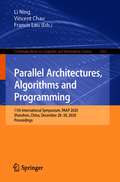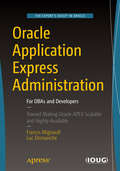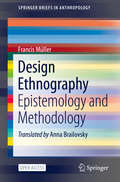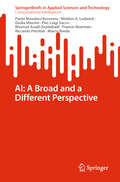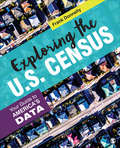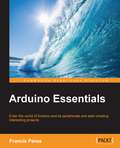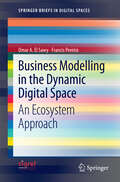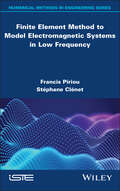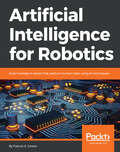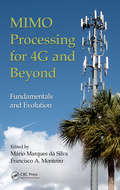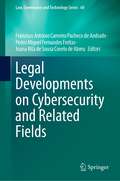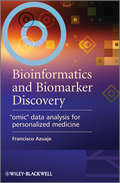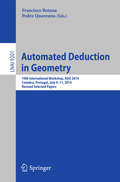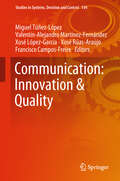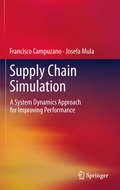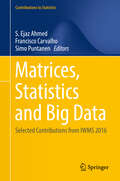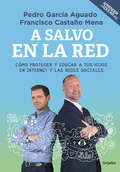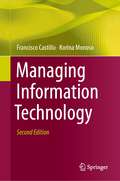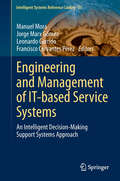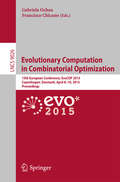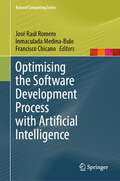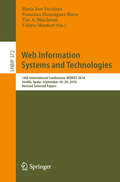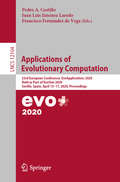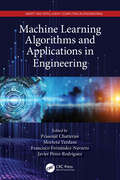- Table View
- List View
Parallel Architectures, Algorithms and Programming: 11th International Symposium, PAAP 2020, Shenzhen, China, December 28–30, 2020, Proceedings (Communications in Computer and Information Science #1362)
by Francis Lau Li Ning Vincent ChauThis book constitutes the refereed proceedings of the 11th International Symposium on Parallel Architectures, Algorithms and Programming, PAAP 2020, held in Shenzhen, China, in December 2020.The 37 revised full papers presented were carefully reviewed and selected from 75 submissions. The papers deal with research results and development activities in all aspects of parallel architectures, algorithms and programming techniques.
Oracle Application Express Administration
by Francis Mignault Luc DemancheSucceed in managing Oracle Application Express (APEX) environments. This book focuses on creating the right combination of scalability, high-availability, backup and recovery, integrity, and resource control. The book covers everything from simple to enterprise-class deployments, with emphasis on enterprise-level requirements and coverage of cloud and hybrid-cloud scenarios. Many books cover how to develop applications in Oracle APEX. It's a tool with a fast-growing user-base as developers come to know how quick and easy it is to create new applications that run in a browser. However, just getting an application off the ground is only a small part of a bigger picture. Applications must be supported. They must be available when users need them. They must be robust against disaster and secure against malicious attack. These are the issues addressed in Oracle Application Express Administration. These are the issues that when tackled successfully lead to long term success in using Oracle APEX as a rapid application-development toolset. Readers of this book learn how to install the Oracle APEX engine in support of small-scale projects such as at the departmental level, and in support of enterprise-level projects accessed by thousands of users across dozens of time zones. Readers learn to take advantage of Oracle Database's underlying feature set in regards to application scalability and performance, integrity, security, high-availability, and robustness against failure and data loss. Oracle Application Express Administration also describes different cloud solutions, integration with Oracle E-Business Suite, and helps in taking advantage of multitenancy in Oracle Database 12c and beyond. Covers important enterprise considerations such as scalability, robustness, high-availability. Describes cloud-based application deployment scenarios Focuses on creating the right deployment environment for long-term success What You Will Learn Install, upgrade, and configure robust APEX environments Back up and recover APEX applications and their data Monitor and tune the APEX engine and its applications Benefit from new administration features in APEX 5. 0 Run under multi-tenant architecture in Oracle Database 12c Manage the use of scarce resources with Resource Manager Secure your data with advanced security features Build high-availability into your APEX deployments Integrate APEX with Oracle E-Business Suite Who This Book Is For Architects, administrators, and developers who want to better understand how APEX works in a corporate environment. Readers will use this book to design deployment architectures around Oracle Database strengths like multi-tenancy, resource management, and high availability. The book is also useful to administrators responsible for installation and upgrade, backup and recovery, and the ongoing monitoring of the APEX engine and the applications built upon it.
Design Ethnography: Epistemology and Methodology (SpringerBriefs in Anthropology)
by Francis MüllerThis open access book describes methods for research on and research through design. It posits that ethnography is an appropriate method for design research because it constantly orients itself, like design projects, towards social realities. In research processes, designers acquire project-specific knowledge, which happens mostly intuitively in practice. When this knowledge becomes the subject of reflection and explication, it strengthens the discipline of design and makes it more open to interdisciplinary dialogue. Through the use of the ethnographic method in design, this book shows how design researchers can question the certainties of the everyday world, deconstruct reality into singular aesthetic and semantic phenomena, and reconfigure them into new contexts of signification. It shows that design ethnography is a process in which the epistemic and creative elements flow into one another in iterative loops. The goal of design ethnography is not to colonize the discipline of design with a positivist and objectivist scientific ethos, but rather to reinforce and reflect upon the explorative and searching methods that are inherent to it. This innovative book is of interest to design researchers and professionals, including graphic artists, ethnographers, visual anthropologists and others involved with creative arts/media.
AI: A Broad and a Different Perspective (SpringerBriefs in Applied Sciences and Technology)
by Paolo Massimo Buscema Weldon A. Lodwick Giulia Massini Marco Breda Francis Newman Masoud Asadi-Zeydabadi Riccardo Petritoli Pier Luigi SaccoOne of the primary objectives of this book is to highlight the profound difference between two types of AI that pursue distinct goals: emulative AI, which seeks to build machines whose output is similar to, or even superior to, that of the human brain, and investigative AI, whose purpose is to make invisible information within data visible by uncovering the laws through which individual behaviors self-organize into collective behaviors. The former is better known, as it serves as a useful tool for automating human labor and generating market profits; the latter is less widely recognized but is more scientifically oriented towards saving lives (in the medical field), explaining otherwise inexplicable phenomena (in the geophysical field), and enhancing our understanding of the material and abstract world. Both are valuable yet distinct: the emulative approach generates immediate profits and creates illusions of human-like power, while the investigative approach enhances fundamental scientific research and will yield its greatest benefits over time. The investigative approach presented in this volume seeks to rebuild the bridge between humanity and nature.
Exploring the U.S. Census: Your Guide to America’s Data
by Francis P. DonnellyExploring the U.S. Census gives social science students and researchers alike the tools to understand, extract, process, and analyze data from the decennial census, the American Community Survey, and other data collected by the U.S. Census Bureau. Donnelly′s text provides a thorough background on the data collection methods, structures, and potential pitfalls of the census for unfamiliar researchers, collecting information previously available only in widely disparate sources into one handy guide. Hands-on, applied exercises at the end of the chapters help readers dive into the data. Along the way, the author shows how best to analyze census data with open-source software and tools. Readers can freely evaluate the data on their own computers, in keeping with the free and open data provided by the Census Bureau. By placing the census in the context of the open data movement, this text makes the history and practice of the census relevant so readers can understand what a crucial resource the census is for research and knowledge.
Exploring the U.S. Census: Your Guide to America’s Data
by Francis P. DonnellyExploring the U.S. Census gives social science students and researchers alike the tools to understand, extract, process, and analyze data from the decennial census, the American Community Survey, and other data collected by the U.S. Census Bureau. Donnelly′s text provides a thorough background on the data collection methods, structures, and potential pitfalls of the census for unfamiliar researchers, collecting information previously available only in widely disparate sources into one handy guide. Hands-on, applied exercises at the end of the chapters help readers dive into the data. Along the way, the author shows how best to analyze census data with open-source software and tools. Readers can freely evaluate the data on their own computers, in keeping with the free and open data provided by the Census Bureau. By placing the census in the context of the open data movement, this text makes the history and practice of the census relevant so readers can understand what a crucial resource the census is for research and knowledge.
Arduino Essentials
by Francis PereaIf you are a hobbyist who wants to develop projects based on Arduino as the main microcontroller platform or an engineer interested in finding out what the Arduino platform offers, then this book is ideal for you. Some prior knowledge of the C programming language is required.
Business Modelling in the Dynamic Digital Space: An Ecosystem Approach (SpringerBriefs in Digital Spaces)
by Francis Pereira Omar A El SawyThis Springer Briefs volume guides the reader in a comprehensive form to design new digital business models. The book provides strategic roadmaps for enterprises in the digital world, and a comprehensive framework to assess new business models. It aligns both, research and a practical perspective through real case study examples. Even extreme scenarios are employed to ensure that innovative approaches are being considered adequately.
Finite Element Method to Model Electromagnetic Systems in Low Frequency
by Francis Piriou Stéphane ClénetNumerical modeling now plays a central role in the design and study of electromagnetic systems. In the field of devices operating in low frequency, it is the finite element method that has come to the fore in recent decades. Today, it is widely used by engineers and researchers in industry, as well as in research centers. This book describes in detail all the steps required to discretize Maxwell’s equations using the finite element method. This involves progressing from the basic equations in the continuous domain to equations in the discrete domain that are solved by a computer. This approach is carried out with a constant focus on maintaining a link between physics, i.e. the properties of electromagnetic fields, and numerical analysis. Numerous academic examples, which are used throughout the various stages of model construction, help to clarify the developments.
Artificial Intelligence for Robotics: Build intelligent robots that perform human tasks using AI techniques
by Francis X. GoversBring a new degree of interconnectivity to your world by building your own intelligent robots Key Features Leverage fundamentals of AI and robotics Work through use cases to implement various machine learning algorithms Explore Natural Language Processing (NLP) concepts for efficient decision making in robots Book Description Artificial Intelligence for Robotics starts with an introduction to Robot Operating Systems (ROS), Python, robotic fundamentals, and the software and tools that are required to start out with robotics. You will learn robotics concepts that will be useful for making decisions, along with basic navigation skills. As you make your way through the chapters, you will learn about object recognition and genetic algorithms, which will teach your robot to identify and pick up an irregular object. With plenty of use cases throughout, you will explore natural language processing (NLP) and machine learning techniques to further enhance your robot. In the concluding chapters, you will learn about path planning and goal-oriented programming, which will help your robot prioritize tasks. By the end of this book, you will have learned to give your robot an artificial personality using simulated intelligence. What you will learn Get started with robotics and artificial intelligence Apply simulation techniques to give your robot an artificial personality Understand object recognition using neural networks and supervised learning techniques Pick up objects using genetic algorithms for manipulation Teach your robot to listen using NLP via an expert system Use machine learning and computer vision to teach your robot how to avoid obstacles Understand path planning, decision trees, and search algorithms in order to enhance your robot Who this book is for If you have basic knowledge about robotics and want to build or enhance your existing robot's intelligence, then Artificial Intelligence for Robotics is for you. This book is also for enthusiasts who want to gain knowledge of AI and robotics.
MIMO Processing for 4G and Beyond: Fundamentals and Evolution
by Mário Marques da Silva Francisco A. MonteiroMIMO Processing for 4G and Beyond: Fundamentals and Evolution offers a cutting-edge look at multiple-input multiple-output (MIMO) signal processing, namely its detection (in both time and frequency domains) and precoding. It examines its integration with OFDM, UWB, and CDMA, along with the impact of these combinations at the system level. Massive M
Legal Developments on Cybersecurity and Related Fields (Law, Governance and Technology Series #60)
by Francisco António Carneiro Pacheco de Andrade Pedro Miguel Fernandes Freitas Joana Rita de Sousa Covelo de AbreuThis book presents a fresh approach to cybersecurity issues, seeking not only to analyze the legal landscape of the European Union and its Member States, but to do so in an interdisciplinary manner, involving scholars from diverse backgrounds – ranging from legal experts to ICT and engineering professionals.Cybersecurity requirements must be understood in a broader context, encompassing not just conventional aspects, but also emerging topics. This can only be achieved through an interdisciplinary approach. Indeed, cybersecurity should be consistently considered in relation to cybercrime and/or cyber defense, while examining it through the lens of specific domains that are intertwined with various legal fields. Moreover, it is crucial to uphold ethical standards and safeguard fundamental rights, particularly regarding personal data protection.By adopting this comprehensive perspective, the significance of cybersecurity in the exercise of public authority becomes apparent. It also plays an essential role in upholding the fundamental values of both individual Member States and the EU as a whole, such as the rule of law. Moreover, it fosters trust, transparency, and effectiveness in market relations and public administration interactions.In turn, the book draws on the expertise of its authors to provide insights into ICT components and technologies. Understanding these elements holistically is essential to viewing every "cyber" phenomenon from a legal standpoint. In addition to the holistic and interdisciplinary approach it presents, the book offers a captivating exploration of cybersecurity and an engaging read for anyone interested in the field.
Bioinformatics and Biomarker Discovery
by Francisco AzuajeThis book is designed to introduce biologists, clinicians and computational researchers to fundamental data analysis principles, techniques and tools for supporting the discovery of biomarkers and the implementation of diagnostic/prognostic systems.The focus of the book is on how fundamental statistical and data mining approaches can support biomarker discovery and evaluation, emphasising applications based on different types of "omic" data. The book also discusses design factors, requirements and techniques for disease screening, diagnostic and prognostic applications.Readers are provided with the knowledge needed to assess the requirements, computational approaches and outputs in disease biomarker research. Commentaries from guest experts are also included, containing detailed discussions of methodologies and applications based on specific types of "omic" data, as well as their integration. Covers the main range of data sources currently used for biomarker discoveryCovers the main range of data sources currently used for biomarker discoveryPuts emphasis on concepts, design principles and methodologies that can be extended or tailored to more specific applicationsOffers principles and methods for assessing the bioinformatic/biostatistic limitations, strengths and challenges in biomarker discovery studiesDiscusses systems biology approaches and applicationsIncludes expert chapter commentaries to further discuss relevance of techniques, summarize biological/clinical implications and provide alternative interpretations
Automated Deduction in Geometry: 10th International Workshop, ADG 2014, Coimbra, Portugal, July 9-11, 2014, Revised Selected Papers (Lecture Notes in Computer Science #9201)
by Francisco Botana Pedro QuaresmaThis book constitutes the thoroughly refereed post-workshop proceedings of the 10th International Workshop on Automated Deduction in Geometry, ADG 2014, held in Coimbra, Portugal, in July 2014. The 11 revised full papers presented in this volume were carefully selected from 20 submissions. The papers show the trend set of current research in automated reasoning in geometry.
Communication: Innovation & Quality (Studies in Systems, Decision and Control #154)
by Miguel Túñez-López Valentín-Alejandro Martínez-Fernández Xosé López-García Xosé Rúas-Araújo Francisco Campos-FreireThis book explores the disruptive changes in the media ecosystem caused by convergence and digitization, and analyses innovation processes in content production, distribution and commercialisation. It has been edited by Professors Miguel Túñez-López (Universidade de Santiago de Compostela, Spain), Valentín-Alejandro Martínez-Fernández (Universidade da Coruña, Spain), Xosé López-García (Universidade de Santiago de Compostela, Spain), Xosé Rúas-Araújo (Universidade de Vigo, Spain) and Francisco Campos-Freire (Universidade de Santiago de Compostela, Spain). The book includes contributions from European and American experts, who offer their views on the audiovisual sector, journalism and cyberjournalism, corporate and institutional communication, and education. It particularly highlights the role of new technologies, the Internet and social media, including the ethics and legal dimensions. With 30 contributions, grouped into diverse chapters, on information preferences and uses in journalism, as well as public audiovisual policies in the European Union, related to governance, funding, accountability, innovation, quality and public service, it provides a reliable media resource and presents lines of future development.
Supply Chain Simulation
by Francisco Campuzano Josefa MulaSupply Chain Simulation allows readers to practice modeling and simulating a multi-level supply chain. The chapters are a combination of the practical and the theoretical, covering: knowledge of simulation methods and techniques,the conceptual framework of a typical supply chain,the main concepts of system dynamics, anda set of practice problems with their corresponding solutions.The problem set includes illustrations and graphs relating to the simulation results of the Vensim® program, the main code of which is also provided. The examples used are a valuable simulation tool that can be modified and extended according to user requirements. The objective of Supply Chain Simulation is to meet the demands of supply chain simulation or similar courses taught at the postgraduate level. The "what if" analysis recreates different simulation scenarios to improve the decision-making process in terms of supply chain performance, making the book useful not only for postgraduate students, but also for industrial practitioners.
Matrices, Statistics and Big Data: Selected Contributions from IWMS 2016 (Contributions to Statistics)
by S. Ejaz Ahmed Simo Puntanen Francisco CarvalhoThis volume features selected, refereed papers on various aspects of statistics, matrix theory and its applications to statistics, as well as related numerical linear algebra topics and numerical solution methods, which are relevant for problems arising in statistics and in big data. The contributions were originally presented at the 25th International Workshop on Matrices and Statistics (IWMS 2016), held in Funchal (Madeira), Portugal on June 6-9, 2016. The IWMS workshop series brings together statisticians, computer scientists, data scientists and mathematicians, helping them better understand each other’s tools, and fostering new collaborations at the interface of matrix theory and statistics.
A salvo en la red
by Francisco Castaño Mena Pedro García AguadoDe la mano de Pedro García Aguado y Francisco Castaño Mena llega el tercer volumen del proyecto «Aprender a educar», centrado esta vez en un tema tan preocupante, complejo y actual como el modo en que debemos proteger a nuestros hijos en internet y las redes sociales. <p><p>¿Cuándo debo comprarle un smartphone a mi hijo? ¿Tengo que establecer unas normas de uso? ¿Cómo le protejo de los riesgos de internet? ¿Cómo controlo que no sufra o haga ciberbullying? Desde su proyecto «Aprender a educar», Pedro García Aguado y Francisco Castaño Mena hacen hincapié en la educación familiar como factor clave de protección para prevenir posibles dificultades con los hijos. En este tercer libro, los autores se adentran en las nuevas tecnologías y muestran a padres y profesores cómo educar en su uso. <p>A salvo en la Red es un manual indispensable para que niños y adolescentes reciban una buena educación digital y les enseñemos a utilizar estas herramientas sin riesgo y sacándoles el máximo partido. Con un lenguaje directo y cercano, los autores nos exponen casos reales de su consulta y nos enseñan que las nuevas tecnologías, usadas de forma correcta, pueden convertirse en grandes aliadas.
Managing Information Technology
by Francisco Castillo Korina MonosoThere are two different, interdependent components of IT that are important to a CIO: strategy, which is long-term; and tactical and operational concerns, which are short-term. Based on this distinction and its repercussions, this book clearly separates strategy from day-to-day operations and projects from operations – the two most important functions of a CIO.It starts by discussing the ideal organization of an IT department and the rationale behind it, and then goes on to debate the most pressing need – managing operations. It also explains some best industry standards and their practical implementation, and discusses project management, again highlighting the differences between the methodologies used in projects and those used in operations. A special chapter is devoted to the cutover of projects into operations, a critical aspect seldom discussed in detail. Other chapters touch on the management of IT portfolios, project governance, as well as agile project methodology,how it differs from the waterfall methodology, and when it is convenient to apply each. In this second edition, besides a number of corrections and updates throughout the text, chapter 8 on “Agile Project Management” replaces the former chapter 8 completely, and chapter 10 on “IT Security” has been newly introduced as this topic has become more and more important for both management and operations during the last six years.Taking the fundamental principles of IT service management and best practices in project management, the book offers a single, seamless reference for IT managers and professionals. It is highly practical, explaining how to apply these principles based on the author’s extensive experience in industry.
Engineering and Management of IT-based Service Systems
by Jorge Marx Gómez Manuel Mora Leonardo Garrido Francisco Cervantes PérezIntelligent Decision-Making Support Systems (i-DMSS) are specialized IT-based systems that support some or several phases of the individual, team, organizational or inter-organizational decision making process by deploying some or several intelligent mechanisms. This book pursues the following academic aims: (i) generate a compendium of quality theoretical and applied contributions in Intelligent Decision-Making Support Systems (i-DMSS) for engineering and management IT-based service systems (ITSS); (ii) diffuse scarce knowledge about foundations, architectures and effective and efficient methods and strategies for successfully planning, designing, building, operating, and evaluating i-DMSS for ITSS, and (iii) create an awareness of, and a bridge between ITSS and i-DMSS academicians and practitioners in the current complex and dynamic engineering and management ITSS organizational. The book presents a collection of 11 chapters referring to relevant topics for both IT service systems and i-DMSS including: problems of selection of IT service providers, optimization of supply chain systems, IT governance decisions, clinical decision support, dynamic user-interface adaptation, re-engineering of processes, and generic decision problems. Advanced IT technologies used in some chapters are: fuzzy multi-criteria mechanisms, semantic processing, data mining processing, and rough sets. Other chapters report traditional DSS mechanisms but used or suggested to be used in innovative mode for IT service engineering and management tasks.
Evolutionary Computation in Combinatorial Optimization
by Francisco Chicano Gabriela OchoaThis book constitutes the refereed proceedings of the 15th European Conference on Evolutionary Computation in Combinatorial Optimization, EvoCOP 2015, held in Copenhagen, Denmark, in April 2015, co-located with the Evo*2015 events EuroGP, EvoMUSART and EvoApplications. The 19 revised full papers presented were carefully reviewed and selected from 46 submissions. The papers cover methodology, applications and theoretical studies. The methods included evolutionary and memetic (hybrid) algorithms, iterated local search, variable neighbourhood search, ant colony optimization, artificial immune systems, hyper-heuristics and other adaptive approaches. The applications include both traditional domains, such as graph coloring, knapsack, vehicle routing, job-shop scheduling, the p-median and the orienteering problems; and new(er) domains such as designing deep recurrent neural networks, detecting network community structure, lock scheduling of ships, cloud resource management, the fire-fighter problem and AI planning. The theoretical studies involved approximation ratio, runtime and black-box complexity analyses.
Optimising the Software Development Process with Artificial Intelligence (Natural Computing Series)
by Francisco Chicano Inmaculada Medina-Bulo José Raúl RomeroThis book offers a practical introduction to the use of artificial intelligence (AI) techniques to improve and optimise the various phases of the software development process, from the initial project planning to the latest deployment. All chapters were written by leading experts in the field and include practical and reproducible examples. Following the introductory chapter, Chapters 2-9 respectively apply AI techniques to the classic phases of the software development process: project management, requirement engineering, analysis and design, coding, cloud deployment, unit and system testing, and maintenance. Subsequently, Chapters 10 and 11 provide foundational tutorials on the AI techniques used in the preceding chapters: metaheuristics and machine learning. Given its scope and focus, the book represents a valuable resource for researchers, practitioners and students with a basic grasp of software engineering.
Web Information Systems and Technologies: 14th International Conference, WEBIST 2018, Seville, Spain, September 18–20, 2018, Revised Selected Papers (Lecture Notes in Business Information Processing #372)
by Tim A. Majchrzak Valérie Monfort María José Escalona Francisco Domínguez MayoThis book constitutes revised selected papers from the 14th International Conference on Web Information Systems and Technologies, WEBIST 2018, held in Seville, Spain, in September 2018. The purpose of the WEBIST series of conferences is to bring together researches, engineers and practitioners interested in technological advances and business applications of web-based information systems. The 12 full papers presented in this volume were carefully reviewed and selected from originally 68 paper submissions. They cover different aspects of Web information systems, namely internet technology, mobile and NLP information systems, service-based information systems, platforms and eco-systems, Web intelligence and Web interfaces.
Applications of Evolutionary Computation: 23rd European Conference, EvoApplications 2020, Held as Part of EvoStar 2020, Seville, Spain, April 15–17, 2020, Proceedings (Lecture Notes in Computer Science #12104)
by Pedro A. Castillo Juan Luis Jiménez Laredo Francisco Fernández de VegaThis book constitutes the refereed proceedings of the 23rd European Conference on Applications of Evolutionary Computation, EvoApplications 2020, held as part of Evo*2020, in Seville, Spain, in April 2020, co-located with the Evo*2020 events EuroGP, EvoMUSART and EvoCOP.The 44 full papers presented in this book were carefully reviewed and selected from 62 submissions. The papers cover a wide spectrum of topics, ranging from applications of bio-inspired techniques on social networks, evolutionary computation in digital healthcare and personalized medicine, soft-computing applied to games, applications of deep-bioinspired algorithms, parallel and distributed systems, and evolutionary machine learning.
Machine Learning Algorithms and Applications in Engineering: Future Trends And Research Directions (Smart and Intelligent Computing in Engineering)
by Morteza Yazdani Prasenjit Chatterjee Francisco Fernández-Navarro Javier Pérez-RodríguezMachine Learning (ML) is a sub field of artificial intelligence that uses soft computing and algorithms to enable computers to learn on their own and identify patterns in observed data, build models that explain the world, and predict things without having explicit pre-programmed rules and models. This book discusses various applications of ML in engineering fields and the use of ML algorithms in solving challenging engineering problems ranging from biomedical, transport, supply chain and logistics, to manufacturing and industrial. Through numerous case studies, it will assist researchers and practitioners in selecting the correct options and strategies for managing organizational tasks.
